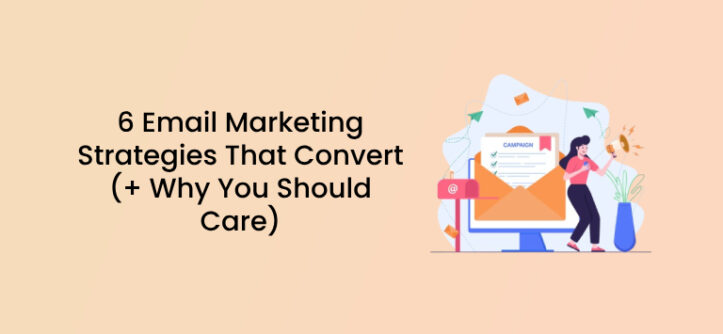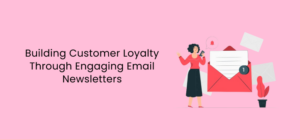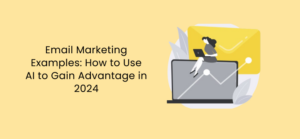Let’s face it: email marketing isn’t just about sending newsletters anymore. It’s a full-blown warzone, and your inbox is the battleground. Millions of messages bombard us daily, vying for precious seconds of attention. So, how do you, the email sender, rise above the noise and actually convert those clicks into customers?
The truth is, cutting through the inbox clutter and achieving conversions is no easy feat. You’re competing with promotional blasts, social media notifications, and that ever-present Netflix queue notification (don’t lie, we’ve all been there). It’s enough to make even the most seasoned marketer throw their hands up in despair.
But first, why even bother with email marketing in the age of social media and flashy platforms? Because email remains the king of engagement. It’s your direct line to your audience, a personal space where you can build trust, nurture relationships, and drive conversions with laser-sharp precision.
Why Should You Care About Email Marketing?
There are 4 billion daily email users. This number is expected to climb to 4.6 billion by 2025. (Statista, 2021). The average inbox receives over 100 emails per day. That’s a lot of competition vying for your audience’s attention.
It’s a lot of potential for businesses like yours. You can send targeted messages, promote your campaigns, and connect deeply with your audience.
Also, nearly 55% of global website traffic is generated from mobile devices, excluding tablets. (Statista, 2022). This means that your audience has ready access to their emails even on the move. They no longer have to wait till they’re home before they check their emails.
Lastly, 46% of smartphone users prefer to receive communications from businesses via email. (Statista, 2021). This is good news for you if you’re serious about growing your email list. You can test different strategies to achieve this including using email popups.
6 Email Marketing Strategies That Convert
1 – Personalization Is Non-Negotiable
People crave information and offers tailored to their specific needs and interests. Personalized emails deliver just that, making them feel valued and understood. When emails resonate with the recipient, they’re more likely to open, read, and interact. This translates to higher open rates, click-through rates, and ultimately, conversions.
Personalization, in this day and age, is not just a nice-to-have in email marketing; it’s a key differentiator in staying relevant.
Over half (52%) of customers hit “unsubscribe” when emails feel impersonal, seeking personalized experiences elsewhere(ActiveTrail). This is a strong indicator of the importance of tailoring your email marketing efforts to individual customers. When an email feels like it’s speaking directly to you, it’s more likely to capture your attention and interest.
Research from Hubspot shows that personalized calls to action demonstrate a remarkable 202% better conversion rate than default or standard calls to action. Personalized CTAs speak directly to individual users’ needs and interests. They’re based on data like browsing history, past purchases, or demographics, making them feel tailor-made, not mass-produced. This relevance grabs attention and resonates deeply, prompting users to take action.
By implementing effective personalization strategies, you can cut through the noise, resonate with your audience, and ultimately drive higher engagement, conversions, and customer loyalty.
2 – Email Content is King (And Queen)
Let’s ditch the niceties and speak plain truth: crappy content gets you ignored. Great content gets you conversions. When people check their emails on their mobile phones, they don’t want to be bombarded with promotions, offers, or emails that they can’t understand or make any sense of.

In email marketing, the quality of your content is the fuel that drives engagement and ultimately, those sweet, sweet conversions.
Why?
Quality content solves problems, not just sells. Nobody wants to feel like they’re being force-fed a sales pitch. Top-notch content addresses your audience’s pain points, offers practical solutions, and provides valuable information. This builds trust and shows you understand their needs, not just your bottom line.
High-quality content is engaging, informative, and even entertaining. It uses storytelling, data-driven insights, and a compelling writing style to keep readers hooked and wanting more.
Great content doesn’t die in the inbox. People share it with friends, colleagues, and social media followers. This organic reach amplifies your message and brings you new leads, all thanks to the killer content you created.
3 – Email Timing is Everything
Sending emails at the optimal time for your audience isn’t about magic hours or lucky days. It’s about strategic targeting based on data and understanding your audience’s habits. Forget vague concepts like “prime time” or “morning sunshine.”. Sending at the right moment can be the difference between your email landing in the abyss of unread messages or sparking interest and clicks.
How?
Firstly, you need to understand your audience. Age, location, and work hours play a crucial role. Targeting a 20-something freelancer in Tokyo at 8 am EST won’t work.
Secondly, analyze the email habits of your audience. Analyze open rates and clicks over time. Do they prefer mornings, evenings, or weekends? Are weekdays or Thursdays better? Look at open and click-through rates by day and hour. Find patterns and peak engagement periods.
If your audience spans multiple time zones, schedule sends based on their local time, not yours. Even within the same country, time zones can create fatigue. If you have a large, geographically diverse audience, consider sending multiple versions of your email at different times throughout the day.
Most email marketing tools offer analytics and suggest optimal send times based on your audience data. Use them to your advantage where possible.
Lastly, don’t just rely on general trends. Test different send times for your specific audience and see what works best. Use email marketing platforms with A/B testing features to compare open and click-through rates for different times of the day.
4 – Mobile Matters Now (More Than Ever)
Today, most adults own a smartphone, and many carry it within arm’s reach throughout the day. This constant access has transformed email from a scheduled activity to a near-instantaneous one.

With 46% of email opens happening on phones (Hubspot), it’s crucial to ensure your emails look great and are easy to read on mobile devices.
We check our inboxes during commutes, coffee breaks, and even while waiting in line. The inbox has become a live feed, constantly demanding attention and blurring the lines between work and personal time.
Mobile screens are smaller and less conducive to reading dense text compared to desktops. This has led to changes in email formatting and content. Emails are now shorter, more concise, and often bullet-pointed, catering to the need for quick consumption on the go.
Emails need to be concise, visually appealing, and scannable to capture attention amidst the digital clutter. Forget lengthy paragraphs and dense text blocks; prioritize bullet points, compelling headlines, and easily digestible snippets. CTA buttons need to be generously sized, text easily readable, and layouts optimized for one-handed navigation.
With inboxes overflowing on smaller screens, subject lines become even more critical. They need to be intriguing, relevant and action-oriented within the constraints of a few words. Craft subject lines that pique curiosity, personalize them for better engagement and avoid clickbait tactics that trigger spam filters.
5 – Email Automation is Your Friend
When used rightly, email automation is a programmable sales machine that automates repetitive tasks, personalizes messaging and increases conversions without you breaking a sweat.
For instance, cart abandonment automated emails earned, on average, a 17.17% open rate for e-commerce merchants (Drip).
Instead of blasting out generic emails to everyone, automation lets you tailor messages based on specific triggers and customer behavior.
What is the key to achieving this?
Track email opens, clicks, and conversions to refine your triggers, sequences, and messaging. Learn from each interaction and optimize your email machine for maximum impact.
Define your triggers. What actions set off an email? Signing up, abandoning a cart, clicking a link? Identify these points in the customer journey.
Design a series of emails tailored to each trigger. Welcome newbies, nudge abandoned carts, nurture leads with valuable content, and re-engage inactive customers.
6 – Testing and Tracking is Key to Success
A/B testing, or split testing, is like running experiments on your audience. You create two (or more) slightly different versions of an email – varying elements like subject lines, calls to action, or offer types. Then, you compare the performance of each version to see which one performs better based on metrics like open rates, click-through rates, and conversions.
No two audiences are the same. Demographics, interests, and preferences within your subscriber list vary. A/B testing allows you to discover what resonates with different segments and personalize your emails accordingly. This leads to increased engagement and click-through rates because the content speaks directly to their needs and desires.
It also eliminates guesswork by providing concrete data on what works and what doesn’t. By analyzing metrics like open rates, click-through rates, and conversions, you can identify areas for improvement and make data-driven decisions about your email strategy. This reduces wasted effort and resources by focusing on what drives results.
Final Thoughts
In conclusion, effective email marketing isn’t just about sending out messages; it’s about crafting personalized experiences that resonate with your audience and drive them to action. By implementing these six strategies, you’ll not only boost your open rates and click-throughs but also cultivate stronger relationships with your subscribers, ultimately converting them into loyal customers and brand advocates.
So, start putting these strategies into practice today and watch your email campaigns blossom into conversions that fuel your business growth.




